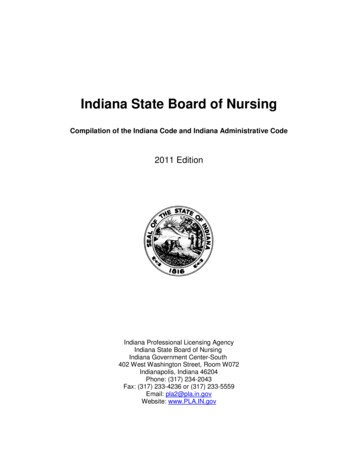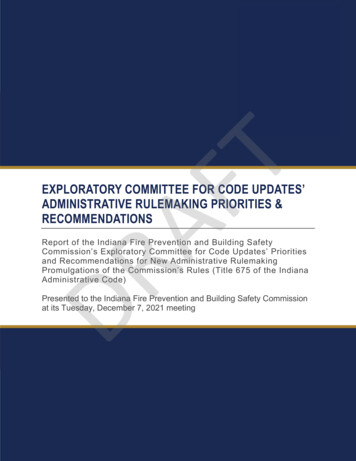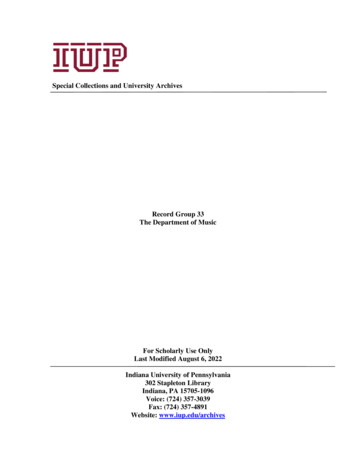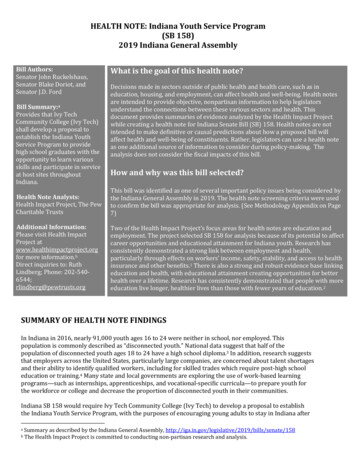
Transcription
Requirements and Guidance forIndiana High School TranscriptsUpdated December 2021Indiana Government Center North, 9th Floor 100 N Senate Ave Indianapolis, Indiana 46204317-232-6610 www.doe.in.gov
INDIANA DEPARTMENT OF EDUCATIONRequirements and Guidelines for Indiana High School TranscriptsIntroductionThis document provides guidance for high school transcripts. It covers the items thatMUST be included, as well as additional items that may be added at the discretion of theschool. It will be regularly updated to address questions posed by administrators andcounselors.Indiana High School TranscriptA high school transcript is the official academic record of the courses and creditscompleted by a high school student. It may be produced in hard copy or electronicformat. An official paper copy of the document contains an official signature and seal ofthe school. An e-transcript submitted through Parchment is also considered an officialtranscript.Common Electronic TranscriptPer IC 21-18-12, by July 1, 2015 all public secondary schools shall use a commonelectronic transcript with common data fields and formats developed by theDepartment of Education, Commission for Higher Education, and state educationalinstitutions. Data fields and additional resources regarding this requirement can befound here. Note that required data fields found on the ‘Common Transcript DataElements’ spreadsheet are noted as ‘CT-R’ (common transcript required) or ‘IC-R’(Indiana Code required).A. Required ComponentsIndiana Code 20-33-2-13 requires that school corporations include the followinginformation in the official transcript of a high school student (A schoolcorporation may include information on a student's high school transcript that isin addition to these requirements):1. Attendance records.2. The student’s latest statewide assessment program results.3. Any secondary or postsecondary certificates of achievement earned by thestudent.4. Immunization information.5. Dual credit courses from the Core Transfer Library taken by the student.In addition to the required components noted in Indiana Code, the commonelectronic transcript requires specific components, which are noted as ‘CT-R’(common transcript required) in the common transcript data elements spreadsheet.A1. Attendance RecordsThough the law does not specify, the Department recommends that the high schooltranscript show, at a minimum, the number of days a student has been absent in theschool year. Schools may include additional attendance information such as2
attendance by semester or trimester, etc. The date of enrollment, date ofgraduation or date of withdrawal or exit interview should also be included.A2. Statewide Test ResultsResults of the most recent Statewide Assessment must be included on the highschool transcript. Schools may opt to include the actual numerical score which ispreferred or just the results (e.g.Pass, Did Not Pass, etc).A3. Secondary or Postsecondary Certificates of AchievementThe term “Certificate of Achievement” refers to any academic or technical award,distinction or honor the student has earned. Examples include an AP Scholarsaward, Biliteracy Certificate, Certified Nursing Assistant (CNA) certificate, NationalMerit Scholarship and other similar awards or certificates. The decision of whatawards and distinctions to list or not list on the transcript is an individual schooldecision. Note that a “Certificate of Achievement” does not refer to a documentgiven to students who are not meeting graduation requirements.A4. Immunization InformationSince required immunizations change frequently, contact your local school nurseforcurrent requirements or review the most current immunization requirementson theHealth Services page of the IDOE website dwellness/health/immunizations/In order to comply with I.C. 20-33-2-13, a school may: list the immunizations on the transcript by entering into the studentinformation system; attach a pdf of immunizations from CHIRP; state “immunization record has been entered into the Indiana StateDepartment of Health immunization data registry (CHIRP)”; or place a verification statement on the student’s transcript stating, “Thestudent’s immunization record is in compliance with IC 20-34-4-1.” If this isthe chosen method, the school must provide a copy of the student’simmunization record maintained by the school pursuant to I.C. 20-34-4-1along with the transcript.To ensure a student’s privacy, do not include any other health information on orwith the transcript. Health records should be maintained separately from thestudent’s transcript. The confidentiality of health records should be strictlymaintained according to federal privacy regulations.A5. Dual Credit CoursesAny dual credit courses listed on the Indiana Core Transfer Library nsfer-library/) that a student takes3
must be listed on the student’s high school transcript. This is part of the statelaw that lists transcript requirements. Note that in order to meet the dual creditoptions for the Technical Honors Diploma and Academic Honors Diploma dualcredit courses do not have to be from the Core Transfer Library but do have tobe on the approved dual credit list*. Therefore, dual credit courses listed on theCTL and the approved dual creditlist (if being used to meet a course or creditrequirement), must be included on thehigh school transcript. Courses should belisted whether the student earns high school or college credits for the course.Effective July 1, 2013, the transcript must reflect that the secondary credits wereearned at an eligible institution (Ex: US History HST 101 Ivy Tech) (see IC 21-43-4-5).*Effective with students who entered high school in the 2012-13 school year (classof2016), dual credit courses must be from the approved dual credit course list to meetthe Academic or Technical Honors diploma option(s).B. Transcript FormatB1. Clarity and Legibility Issues Transcripts should be typed or computer-generated.o No handwritten items including corrections or insertions should beincluded. Photocopies must be clear and readable. State approved course titles and four-digit state course numbers must beused (CT-R) Standard course abbreviations are suggested.o See the ‘Abbreviation’ column in the “Indiana High School CourseTitles Summary,” at https://www.in.gov/doe/students/indiana-academic standards/course-titles-and-descriptions/.Course records should be listed chronologically by grading period.B2. High School/Corporation InformationTranscript should include: High school name, address, phone number, Indiana Department of Education(IDOE) high school code (four digits), name and email address of a contactperson, and high school website School corporation name, address, phone number, IDOE school corporationcode (four digits), school corporation website, and corporation contact forstudent records Grading scale used by the school Official school seal and authorized official signature if submitting in paperformat College Board six digit CEEB (or AI) code (CT-R)4
B3. Student InformationTranscript should include a student’s: Full legal name, home address, phonenumber, email address for student Gender Date of birth Student Test Number (STN) Name(s) of parent(s) or legal guardian(s) Grade level at time transcript is preparedB4. Student Academic Information Schools should use Indiana state-approved course titles and four-digit coursenumbers (or approved non-standard course titles): See list and course codes at: andards/course-titles-and-descriptions/ All courses to becounted toward a student’s diploma requirements must belisted on the highschool transcript with grades and credits (including PE andHealth courses)and factor into the cumulative GPA. Designation of diploma type awarded should be included:o Generalo Core 40o Core 40 with Academic Honorso Core 40 with Technical Honorso International Baccalaureate Cumulative grade point average (GPA) should be calculated by semester,trimester, or on an annual basis. The total number of credits earned by thestudent should also be listed. Class rank may be listed at the option of the school. No Pass/Fail grades are to be listed for Core 40 or Honors diploma candidatesand may not be used for the 34 (of the 40) credits required for the GeneralDiploma. The listing of course retakes, audits, etc. may be decided locally. Honors and/or weighted courses should be clearly identified. Dual credit courses should be listed according to the information in theQuestions & Answers (Q.9) section below. Credits for courses completed before grade nine should be listed accordingto the information in the Questions & Answers (Q.4) section below. College Board policy suggests that PSAT/NMSQT scores not become part ofany student’s transcript or permanent record that is routinely shared withoutside entities, such as colleges, scholarship organizations, or potentialemployers. Read more in the Questions & Answers section below (Q.14). ACT policies (see www.act.org) allow schools to locally decide whether to listACT scores on a student’s transcript.5
Testing scores such as scores for ASVAB, Work Keys or other assessments, inaddition to Statewide Assessment results, may be included but are notrequired. Guidance regarding the inclusion of Advanced Placement (AP)scores can be found inQ. 22 below.Notations referencing credits that were earned through an alternativeeducation program, correspondence course, online course, etc. are notappropriate. If the course covers the Indiana Academic Standards requiredfor the course, no additional notation is needed.School awards and/or honors earned in Grades 9-12 such as Salutatorian,Valedictorian, Honor’s Society, etc. may be listed but are not required.B5. Special Education Students: No disclosure of disability should be noted on a transcript. Where accommodations are used to meet state course standards, gradesshould not be listed as adjusted or modified. In cases where a student’s IEP allows for accommodations to help thestudent master the academic standards of a state-approved course, nodistinction needs to be made to the course title on the transcript. Forexample, if a student’s approved accommodations are used to help thestudent master the content of Algebra I, the course should be listed on thetranscript as Algebra I instead of Algebra I-SP (or other differentiation).However, if modifications or changes are made to the required coursestandards or content, the official state course title should not be used. Inthese situations, you would use the “Applied” Course Title and the studentwould earn Applied Units towards a Certificate of Completion.B6. English Learner (EL) Students: A student’s English Language Proficiency level, as determined throughthe administration of the annual WIDA ACCESS assessment, may beincluded on thetranscript. This is a local decision. Schools may opt toinclude the student’s overall proficiency score as determined by theannual language assessment.COMMON QUESTIONS & ANSWERS1. Can subjective comments or recommendations be included on the transcript?It is not recommended. If a school wishes to provide subjective comments orrecommendations for the student at the student’s request, that information shouldbe put into a separate letter.2. How should it be recorded if a student fails a course but then retakes it and6
passes?This is a local school corporation or school governing body decision.3. How would the GPA be figured if a student fails a course but then retakes it andpasses?This is a local decision. If the grade is noted on the transcript, it should be factoredinto the GPA.4. How should a high school credit earned prior to high school be recorded?If the local school corporation policy is to issue high school credit for courses takenin middle school, and the course is equivalent to its high school counterpart andtaught by a highly qualified teacher, the course should be noted on the transcript inthe same way the other courses are noted. The grades and credits must be includedon the transcript if being used to meet high school diploma requirements.Refer to the IDOE memo on HS Credit for Courses Completed Prior to Grade aken-ms.pdf.5. How are courses and outcomes for non-diploma track students recorded?See section B5 above.6. How does a student qualify for a GQE/Graduation Pathways waiver, and shouldit or a Certificate ofCompletion or Achievement be identified on the transcript?Waiver information is in IC 20-32-4-4. The Department recommends that waiverinformation not be recorded on the transcript. A waiver simply means that thestudent accomplished the requirements but that a different assessment mechanismwas used. Information about non-diplomas (Certificate of Completion,Achievement, etc.) can be found in the “Diplomas and Certificates Considerations”memo.7. Who can request that a transcript be sent to an institution?A parent, or student after the student has turned 18, may request that a transcriptbe sent to an institution of higher education or vocational program. The FamilyEducational Rights and Privacy Act (FERPA) permits schools to afford minorstudents’rights in addition to those given to parents. Once a student turns 18 yearsold, the rights under FERPA transfer from the parents to the student. This may alsobe true for emancipated minors. Indiana does not have a specific statutepermitting a minor child to seek a court order emancipating the child from his or herparent(s).7
Instead, Indiana law recognizes that a child may, in some circumstances, beemancipated for purposes of child support. In those situations, an Indiana court maydeem the child emancipated and order the termination of a support order;however, this order does nothing change any other rights or obligations of thechild’s parents, nor does the order provide additional rights to the student. Thatbeing said, if a minor has been deemed emancipated by a court order, that minorshould be afforded similar access to his or her student records in the same manneras the student’s parent(s) and should be treated, for purposes of FERPA, as an adult.When the student attends a postsecondary institution, even if he or she is under 18years of age, the student may review the record in the postsecondary institution.The provisions of FERPA are as follows:Generally, schools must have written permission from the parent or eligiblestudent in order to release any information from a student’s education record.However, FERPA allows schools to disclose those records, without consent, tothe following parties or under the following conditions (34 CFR § 99.31): school officials with a legitimate educational interest; other schools to which a student is transferring; specified officials for audit or evaluation purposes; appropriate parties in connection with financial aid to a student; organizations conducting certain studies for or on behalf of the school; accrediting organizations; to comply with a judicial order or lawfully issued subpoena; appropriate officials in cases of health and safety emergencies; and state and local authorities, within a juvenile justice system, pursuanttospecific state law.When a record is disclosed in the types of situations indicated above, theoriginating agency must note in the record the names of the parties whoreceived the information and an explanation of the legitimate educationalinterest under the record was disclosed. FERPA requires agencies or schools toaccount for all education records release, indicating the reasons theinformation was provided and who received it. These explanations must berecorded in the student’s record and maintained there until the agencydestroys the record.Schools may disclose, without consent, “directory” information, such as astudent’s name, address, telephone number, date and place of birth, honorsand awards, and dates of attendance. However, schools must tell parents andeligible students about directory information and allow parents and eligiblestudents a reasonable amount of time to request that the school not disclosedirectory information about them. Schools must notify parents and eligiblestudents annually of their rights under FERPA. The actual means of8
notification (e.g., special letter, inclusion in a PTA bulletin, studenthandbook, or newspaper article) is left to the discretion of each school.For additional information or technical assistance on FERPA, call(202) 260–3887.8. What immunization records need to be part of the transcript and where are theyavailable?Required immunizations change frequently. Contact your local school nurse forcurrent requirements or review a copy of the most current immunizationrequirements posted on the Health Services page of the IDOE website. To ensure astudent’s privacy, do not include any other health information on the transcript.Parent permission must be on file before any part of the student’s record can beaccessed or recorded outside of the school’s permanent or health records.9. How should dual credits be listed on the transcript?Dual credit courses must be titled in one of two ways on the high school transcript:1. Use a combination of the college course title and the appropriate stateapprovedhigh school course title if it has been determined that the dual creditcollege course meets the Academic Standards for the corresponding high schoolcourse. For example, a college-level American History course – HST 101 from IvyTech Community College – may appear on the high school transcript as “USHistory/HST 101 Ivy Tech.” In these instances, the state-approved high schoolcourse title should be listed first, followed by the college course number and theeligible institution where the credits were earned.Note that the student’s high school transcript must reflect that the secondarycredits were earned at an eligible institution.2. If the course is taught on the college campus or through the college campus(online or by a visiting faculty member), there may be no aligned, correspondinghigh school course. In this situation, approved course titles by content areawould read “Advanced, College Credit/College Course Title (InstitutionName). For example, Advanced Business, College Credit/ACC 202 (BSU).Additional Advanced College Credit course titles can be found in the CourseTitles and Descriptions.For more complete information regarding the correlation of high school dualcredit courses to the post-secondary courses, see the Dual Credit Crosswalks forliberal arts and CTE (https://www.in.gov/doe/students/dual-credit/). These Advanced course titles are not typically used for dual credit coursestaught in a high school class by high school faculty, unless otherwise indicated.9
3. Course titles may be abbreviated (e.g., Adv. Comp), but must be used inconjunction with the college course title, number, and institution (e.g., Adv.Soc Studies CC/HST 101, Institution). Note that the maximum size for the‘State Course Name/Title electronic transcript data field is 60. When space on the transcript is limited, it is permissible to put an asteriskor subscript notation on the high school course title and list more detailsabout thedual credit course in a “miscellaneous” or “notes” section of thetranscript to include the number of college credits earned.As a result of legislation that passed in 2013, on July 1, 2015, it became arequirement for all public secondary schools to use the common electronictranscript, which includes a dual course designation under ‘Enrollment Type.’*Note that for college admissions purposes, the college credit would need to betranscripted and therefore the student should request to have a transcript sent fromthe postsecondary institution where the dual credit was earned to the institution forwhich they are applying for admission.For more information regarding specific Advanced coursework questions,contact theIDOE for further clarification and guidance.10. How should credits earned through a virtual environment, credit recoverysituation, or credits earned by demonstration of proficiency be recorded on thetranscript?These courses should be noted the same way you would record classes takentraditionally as long as they cover the respective content in the Course Descriptionand Academic Standards. No additional notations should appear beside thesecourses since student’s had to have met course standards in order for credit to beawarded.11. If a student tests out or demonstrates proficiency without taking a course, howshould it be noted on the transcript?How or if it is recorded on the transcript, is a local decision. However, only thosecourses listed on a HS transcript with grades and credits count for graduation. TheState Board of Education made this decision several years ago because grades areconsidered when determining a student’s GQE/Graduation Pathway waiver andstatus for financial aid. For example, if a student tests out of Algebra I and you putcredits but not grades on the HS transcript, those credits would not apply towardthe graduation requirements and that student would need three more years of Core40 math courses to meet the Core 40 requirement.10
12. If a student completed Algebra I in middle school and has met the required 8credits for the AHD (without counting the Algebra I credits), would theAlgebra I course have to be included on the transcript and would the GPAhave to befactored into the student’s cumulative GPA?Technically, Algebra I credits don't have to appear on a student's high schooltranscript if the student has six (Core 40) or eight (AHD) math credits in courses ata higher level than Algebra I (including Algebra II). Six math credits mustbe earnedduring grades 9-12. See more information here.13. Can a student take a class for a pass/fail grade if they are trying to earn theGeneral Diploma?No Pass/Fail grades are allowed for courses that count toward the Core 40 andHonors diplomas. GQE/ECA waivers require grades of “C” or higher in 34 of the 40required and elective courses that count for the GQE/ECA waiver so they could notbe Pass/Fail. P/F grades may be used with the General Diploma as long as they arein addition to the 34 (of the 40) required and elective courses that count for the GQEwaivers. Physical education and health are both required courses, so P/F is not anoption for any diploma for these courses.14. If a school corporation has questions regarding the use of the Indiana ETranscript/Parchment who might they contact?Contact Matt Sterenberg at Parchment – msterenberg@parchment.com*Note that by July 1, 2015, all public schools shall use a common electronictranscript to be developed by the Department of Education, state educationalinstitutions, and the Commission for Higher Education per IC 21-18-12.15. Are there other ways to meet the PE/Health credits so the transcript reflects thatthe student met diploma requirements?Yes. Below are a few alternative options.1) 511 IAC 6-7.1-9 states that a school board may recognize military experience.Amaximum of four credits may be recognized for basic training (2 credits forphysical education and 2 credits for health and wellness with one creditgrantedfor each three months of service)2) 511 IAC 6-7.1-4 states that the health and wellness credit requirement may bewaived for a student if the student’s program includes:o Three credits for the following family and consumer sciences courses: ChildDevelopment and Parenting, Human Development and Family Wellness,Interpersonal Relationships, Nutrition and Wellness, or Preparing for College11
and or careers.3) For a student who qualifies under the religious objection provision of IC 20-30-59 (hygiene instruction), a one credit substitution of either a science, family andconsumer sciences, or health and physical education credit may be used to fulfillthe Health and Wellness credit requirement.4) In 2009, the State Board of Education made several rule changes, including thedefinition of credit, to allow schools more flexibility in working with students andengaging them in challenging content. Students can earn PE credit usingalternative options, but it is important to note that all required PE standardsmuststill be met and the credit granted by an appropriately licensed PE teacher.Additional information can be found here.16. Will the NCAA accept credits earned before Grade 9?Yes, a high school course taken in the eighth grade may be used if the course is onthe student’s high school transcript with a grade and credit and if the course is onthe high school's List of NCAA-Approved Core Courses.17. Where can I find more information about NCAA guidelines?The NCAA High School portal is athttps://web1.ncaa.org/hsportal/exec/hsAction.18. What types of nontraditional programs/courses may not be accepted by theNCAA?Be aware that not all nontraditional educational programs/courses meet NCAA corecourse requirements. The NCAA cautions schools to be careful “with online,correspondence, credit recovery or other types of nontraditional courses that: Do not have teacher-based instruction. Do not require regular and ongoing interaction between the student and theteacher. Do not have certified or qualified teachers. Do not require students to complete the entire course. Allow students to complete a course in a short period of time. Allow students to take numerous courses at the same time, especially courses inthe same subject area, or that are sequential in nature (e.g., Algebra I, Geometryand Algebra II at the same time).Do not prepare students for four-year college classwork.Do not verify a student’s identity.Have no formal assessments or limited assessments.12
Have no official student-grade records (e.g., transcript, grade report, studentcourse activity information).”19. If a student transfers to an Indiana school from another high school, do thecourses already listed on their transcript need to be changed to reflect Indiana’sstate approved course titles? Do we have to accept the courses on theirtranscript?Indiana high schools have the local option of determining whether or not to acceptcredits from another high school. In cases where courses taken at the sendingschool are determined to align with Indiana high school courses, the previous coursetitle may be used or converted to the Indiana course title. Oftentimes an electivecourse title, even those not in Indiana’s list of course titles, are transferred, as is, tothe receiving high school transcript.If it is determined at the local level that the course is equivalent to an Indianacourse, a school may count these credits. If the course taken at the student’sprevious school is not equivalent, the school could include the course on thetranscript but may decide that it can’t be counted towards graduationrequirements. If there is a question as to whether the student mastered thecoursestandards and content, your high school has the option of allowing the student to“demonstrate proficiency” through the use of an end-of-course assessment or finalexam from an equivalent course. Alternatively, a teacher or department chair fromthat content area may verify a student’s proficiency withoutan exam.While schools have wide latitude on how to accept credits from another high school,it is important that the policy be consistently and fairly applied. For example, a localpolicy that accepts, without question, transfer credits from an out-of-state publicschool but rejects transfer credits from a local non-public, non-accredited highschool – without determining a student’s proficiency or knowledge in that subjectarea – might be considered discriminatory.20. What additional information might be helpful to send a postsecondary institution?Postsecondary institutions like to see a high school profile included with thestudent’s transcript. This might include the following: School Counselor’s Contact Information Number of AP, IB, dual credit courses offeredGrading scale usedDetermination of class ranking and designation of Valedictorian, Salutatorian,etc.Statistics on % of students who attend college13
21. Advanced Placement (AP) scores be listed on a high school transcript?Per the 2015-16 AP Coordinator’s Manual, only students have the right to forwardtheir AP scores to colleges and universities. Therefore, schools should use caution inaffixing AP score labels to transcripts or other records that will be sent to theseinstitutions. Affixing score labels to transcripts can result in a violation of students’rights and may expose schools to potential lawsuits. To avoid this possibility, the APProgram strongly suggests that schools institute one of the following procedures:a. Affix the AP score label to the back of the transcript and copy onlythe front of the transcript when sending it to colleges.b. Have students sign a release permitting the school to put thescore report label on the front of the transcript. Keep the signedreleases with students’ files.RESOURCESIndiana Academic StandardsDiploma and Certificate ConsiderationsCourse Titles and DescriptionsDiploma requirements, 511 IAC 6-7.1SummariesE-transcripts/ParchmentFamily Educational Rights and Privacy Act (FERPA)World Education Service Resources- Regarding Transfer Credits of International StudentsImmunization RequirementsIHSAANCAA Eligibility CenterTranscript Legislation, IC 20-33-2-1314
DEFINITIONSThe following definitions may be helpful in preparing a student’s transcript.AbsenceAn absence occurs whenever a student is not in school when school is in session and thestudent is not engaged in an educational activity approved by the local school board orschool administrative staff. Whether the absence is excused or unexcused, it is to berecorded as an absence on the official transcript. There are statutory exc
A high school transcript is the official academic record of the courses and credits completed by a high school student. It may be produced in hard copy or electronic format. An official paper copy of the document contains an official signature and seal of the school. An e-transcript submitted through Parchment is also considered an official











